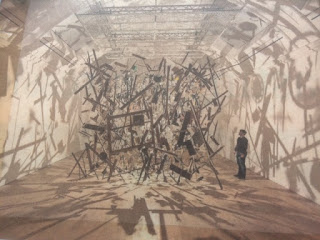Mosaics
For a period of at least fifteen years, I spent two weeks of each summer in Italy. During that time I made a point of seeing all the art and architecture which interested me. The one famed centre I didn’t visit was Ravenna. I had not been impressed by the reproductions I had seen of the mosaics there. But this year, I did visit the city.
Undeniably, there is a certain magnificence to the churches and other buildings that house the famous mosaics, but seeing them in actuality has not substantially changed my opinion. If I were to choose my most memorable passage, it would be the ‘three kings’ section in
S. Apollinare. Balthazar, Melchior and Gaspar prance forward with their gifts, in decorative tights that would not disgrace the trendiest of fashion magazines and their side-on posture is a welcome relief from full-frontal saints and dignitaries. But seeing them was not an experience like first seeing works by Massacio, Mantegna, Piero della Francesca, Alberti, Giotto, or
Boromini - or even Sanmicheli’s gates in Verona. And yet I love Roman mosaics. What is so different about the latter?
Since my return, I have been obsessed with mosaics and the difference between Roman and later church mosaics. For some time, I have pasted in my scrapbook every Roman mosaic I have come across in magazines or newspapers, and, thanks to my much-travelled daughter, I have a very good book of Roman mosaics in Tunisia.
Comparing the two styles, one thing is immediately noticeable: the Roman mosaicists never have their imagery on anything other than light backgrounds. They have devices for maintaining this, even in handling complex compositions. In a scene of rural life from the House of the Laberri at Oudhna, a building, some oxen and a man ploughing, and various other livestock, wildlife and hunters are all included by giving each item a bit of dark ground to stand on. The church mosaics do not have the same tonal contrasts and incorporate coloured glass paste and lots of gold, which is something which I abhor in any pictorial art work.
Yet I did enjoy my visit to Ravenna. The National Museum is well worth visiting and was devoid of other tourists, and not far away is Faenza, with a wonderful museum of ceramics from all continents and all ages. There is also an impressive neoclassical townhouse.
And there are mosaics in the Roman style at Ravenna. An archeological site was opened under a church in 2002, and it shows the floor of a Byzantine palace with wonderful geometric patterns. Two pictorial parts have been removed and are displayed upright. Both are have parts missing. In one case, it is almost the whole figure from a five-figure group, but a full reading of the other is not really impaired, and it is very fine.
On the walls of the Basilica of St. John the Evangelist, some medieval floor mosaics have been arranged. These are very simple pieces and in some cases grossly inept, but they have inspired me to imitate some of their effects in linocuts. I was intrigued by the way trees were handled in one panel and have combined it with dog walkers I see from my studio window in one example. Another exhibit in the church shows how effective a simple line of dark tesserae on a light background can be. In the panel in question, the charm is completely ruined by partly filling in a figure on the ship depicted with bright-orange glass paste. I have already made a sketch for a ship of my own not so defiled. Another instance of my slightly mad endeavour to imitate mosaics in lino cutting is the lettering of two couplets of odd-fact verse in a piece I have produced.





Comments
Post a Comment